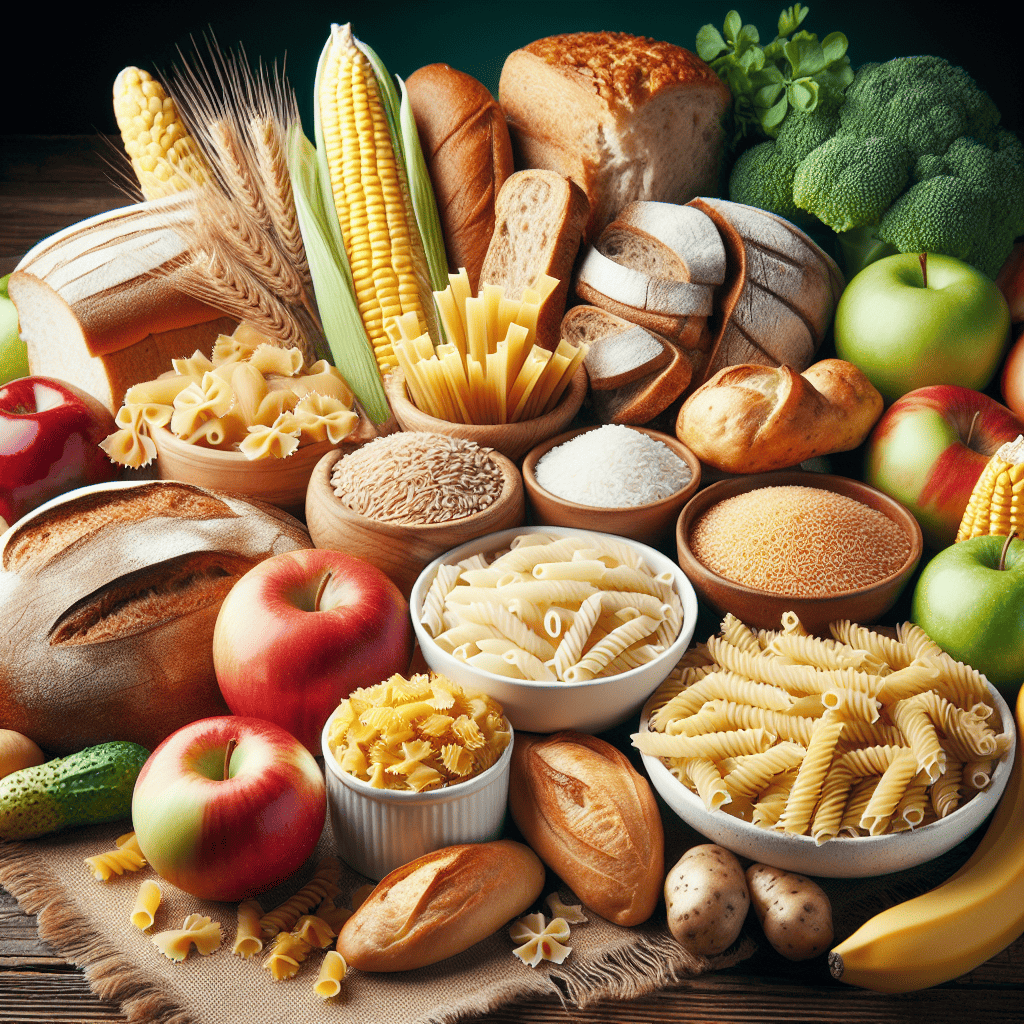Introduction: Carbohydrates play a crucial role as the primary source of energy for the body. This blog post delves into the intricacies of different types of carbohydrates such as sugars, starches, and fiber, offering insights into their classifications, sources, and effects on overall health and nutrition.
Table of Contents
Sugars
Explore the realm of sugars, simple carbohydrates that have a significant impact on blood sugar levels and overall health.
- Types of Sugars:
Natural sugars are those that occur naturally in foods such as fruits and milk. These sugars are accompanied by essential nutrients like vitamins, minerals, and fiber. When consumed in whole foods like fruits, the natural sugars are digested more slowly, leading to a gradual release of energy. This can help regulate blood sugar levels and prevent energy crashes. It is generally recommended to choose whole fruits over fruit juices or processed foods, as the latter often contain added sugars and lack the beneficial nutrients present in whole fruits.
On the other hand, manufactured sugars, also known as added sugars, are sugars that are not naturally present in foods but are incorporated during processing or preparation. These sugars are commonly found in sugary beverages, candies, baked goods, and many other processed foods. While they provide sweetness and enhance flavor, added sugars offer empty calories and no nutritional value. Consuming too much added sugar has been linked to various health issues, including obesity, type 2 diabetes, and heart disease. It is important to be mindful of hidden sugars in packaged foods by checking ingredient lists and nutrition labels.
In order to maintain a healthy diet, it is advisable to limit the intake of manufactured sugars and focus on consuming natural sugars from whole foods. This can be achieved by opting for fresh fruits, vegetables, and dairy products as sources of sweetness. Moderation is key when it comes to sugar consumption, and being aware of the type of sugars present in different foods can help individuals make better food choices. By prioritizing whole, nutrient-dense foods and minimizing processed items high in added sugars, one can promote overall well-being and reduce the risk of diet-related health issues.
- Names of Sugars in Products:
When it comes to checking food labels for sugar content, it’s important to be vigilant as sugars can be disguised under various names. These different names for sugar include agave syrup, corn syrup, dextrose, fructose, sucrose, honey, sugar, and molasses. By familiarizing oneself with these aliases, individuals can better identify hidden sugars in the ingredients list of food products. It’s common for manufacturers to use these alternate names to obfuscate the actual sugar content of their products, making it challenging for consumers to make informed decisions about their food choices.
Agave syrup, for example, is often marketed as a healthier alternative to traditional sugar due to its perceived natural origins. However, it is crucial to understand that agave syrup is still a form of sugar and can have similar effects on the body as other sweetening agents. Similarly, corn syrup, which is widely used in processed foods, can be listed on labels in different forms like high-fructose corn syrup. This is important to note because high-fructose corn syrup has been linked to various health issues like obesity and diabetes when consumed in excess. By being aware of the various names under which sugars can be hidden, consumers can more effectively monitor their sugar intake and make more informed choices for their health.
Recognizing the multitude of names for sugar on food labels can empower individuals to make healthier decisions about their eating habits. Whether it’s dextrose in a seemingly harmless snack or sucrose hidden in a savory sauce, understanding these aliases can help consumers avoid unintentionally consuming excessive amounts of sugar. Furthermore, this knowledge can also be valuable for individuals with dietary restrictions related to sugar consumption, such as those managing diabetes or trying to reduce their overall sugar intake. By carefully scrutinizing food labels for these hidden sugars, people can take control of their diet and prioritize their health and well-being.
Starches
Discover the complexity of starches, a key source of sustained energy for the body.
- Types of Starches:
Starches, a type of carbohydrate, can be classified into two main categories based on how quickly they are broken down in the body: slow-digesting and fast-digesting starches. Slow-digesting starches, also known as complex carbohydrates, take longer to be digested and absorbed by the body. Foods high in slow-digesting starches include whole grains, legumes, and starchy vegetables like sweet potatoes. These types of starches provide a steady release of energy over an extended period, helping to maintain stable blood sugar levels and keeping you feeling full and satisfied for longer periods.
On the other hand, fast-digesting starches, also referred to as simple carbohydrates, are quickly broken down by the body, leading to a rapid spike in blood sugar levels. Foods containing fast-digesting starches include white bread, sugary cereals, and baked goods made with refined flour. While these foods can provide a quick source of energy, they are often lacking in essential nutrients and can lead to fluctuations in blood sugar levels, causing feelings of fatigue and cravings for more food shortly after eating.
Understanding the difference between slow-digesting and fast-digesting starches is crucial for managing energy levels effectively and promoting overall health and well-being. By incorporating more slow-digesting starches into your diet, such as whole grains and vegetables, you can support sustained energy levels, improve satiety, and enhance overall nutrient intake. Limiting the intake of fast-digesting starches, like processed foods and sugary snacks, can help prevent spikes and crashes in blood sugar levels, reducing the risk of energy slumps and supporting weight management goals.
- Sources of Starches:
Starches are complex carbohydrates that serve as a primary source of energy for the human body. They are found abundantly in various staple food items like peas, corn, potatoes, beans, lentils, oats, barley, and rice. These starch-rich foods are vital for providing the body with the necessary fuel to carry out daily functions and activities. When consumed, starches are broken down into glucose, which is then used by the body as a readily available source of energy. It is essential to include these starchy staples in a balanced diet to ensure adequate energy intake and utilization.
Peas are a good source of starch and are often consumed as a side dish or included in soups and stews for added texture and flavor. Corn, in its various forms like corn on the cob, cornmeal, or popcorn, is another staple rich in starch. Potatoes, a versatile vegetable that can be prepared in numerous ways, are a significant source of starch and a staple in many cuisines worldwide. Beans and lentils, commonly used in vegetarian and vegan diets as a protein source, are also excellent sources of starch. Oats and barley are whole grains that are not only rich in starch but are also packed with fiber and essential nutrients. Rice, a staple food for a large part of the global population, provides a substantial amount of starch and is a primary energy source for many cultures.
By understanding the sources of starches such as peas, corn, potatoes, beans, lentils, oats, barley, and rice, individuals can make informed decisions about their dietary choices to optimize their energy intake and utilization. Incorporating a variety of these starch-rich staples into meals ensures a well-rounded and balanced diet. Whether consumed as a main dish, side dish, or snack, these foods not only provide essential energy but also offer a range of nutrients vital for overall health and well-being. With the right knowledge and food choices, individuals can harness the power of starches to support their daily activities and promote optimal physical and mental performance.
Fiber
Unravel the benefits of fiber, a complex carbohydrate that aids in digestion, satiety, and overall well-being.
- Sources of Fiber:
Fiber-rich foods are essential for maintaining good digestive health and overall well-being. Legumes, such as beans and lentils, are excellent sources of fiber. They are also packed with nutrients like protein and vitamins, making them a great addition to any diet. Vegetables like broccoli, brussels sprouts, and spinach are not only rich in fiber but also provide essential vitamins and minerals that are vital for the body’s proper functioning.
Fruits with skins, such as apples, pears, and berries, are high in fiber and antioxidants. The skins of these fruits contain insoluble fiber, which adds bulk to the stool and helps regulate bowel movements. Whole grains like oats, quinoa, and brown rice are another excellent source of fiber. They also offer a wide range of nutrients like B vitamins, iron, and magnesium. Including these grains in your diet can help prevent constipation and promote a healthy gut microbiome.
Nuts like almonds, walnuts, and pistachios are not only tasty snacks but also rich in fiber and healthy fats. They provide a satisfying crunch while offering a good amount of dietary fiber. Incorporating a variety of fiber-rich foods into your meals can aid in weight management, reduce the risk of chronic diseases like heart disease and diabetes, and improve overall digestive health. Therefore, making an effort to include legumes, vegetables, fruits with skins, whole grains, and nuts in your daily diet can have lasting benefits for your well-being.
- Importance of Fiber:
Fiber is a type of carbohydrate that the body can’t digest, but it plays a crucial role in maintaining good gut health. By consuming fiber gradually instead of all at once, you allow your digestive system to adjust and process it more effectively. This gradual consumption also helps prevent issues like bloating or stomach discomfort that can occur when too much fiber is consumed quickly. Furthermore, fiber acts as a prebiotic, feeding the beneficial bacteria in your gut. These bacteria play a key role in digestion, nutrient absorption, and even in the regulation of the immune system. Therefore, by maximizing fiber intake through gradual consumption, you can support a diverse and healthy gut microbiome, which in turn can contribute to better overall physical well-being.
Hydration is another crucial factor in maximizing the benefits of fiber. Soluble fiber, found in foods like oats, beans, and fruits, absorbs water as it moves through the digestive system, helping to soften stools and promote regular bowel movements. However, if you are not properly hydrated, fiber can have the opposite effect and lead to constipation. Therefore, ensuring ample hydration is essential when increasing fiber intake. Drinking plenty of water throughout the day not only supports the movement of fiber through the digestive tract, but it also helps maintain overall digestive health. Adequate hydration is key to preventing issues such as bloating, constipation, and even more serious conditions like diverticulitis.
Incorporating a variety of fiber-rich foods into your diet, such as whole grains, fruits, vegetables, nuts, and seeds, can help you reap the benefits of this essential nutrient. Along with gradual consumption and adequate hydration, a diverse fiber intake can have a positive impact on various aspects of your health, including lowering cholesterol levels, stabilizing blood sugar, and reducing the risk of certain chronic diseases. By making fiber a priority in your diet and adopting healthy habits like gradual consumption and staying hydrated, you can optimize your gut health and enhance your overall well-being.
References
List of sources used for gathering information on carbohydrates and their impact on health.




